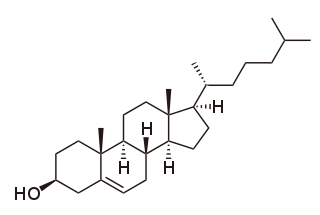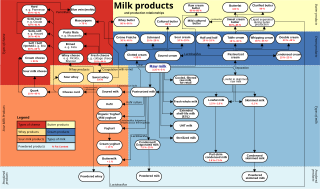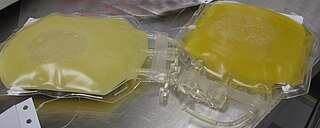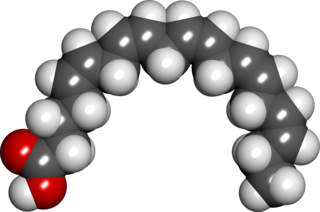Related Research Articles

Cholesterol is the principal sterol of all higher animals, distributed in body tissues, especially the brain and spinal cord, and in animal fats and oils.

Dairy products or milk products, also known as lacticinia, are food products made from milk. The most common dairy animals are cow, water buffalo, nanny goat, and ewe. Dairy products include common grocery store food around the world such as yogurt, cheese, milk and butter. A facility that produces dairy products is known as a dairy. Dairy products are consumed worldwide to varying degrees. Some people avoid some or all dairy products because of lactose intolerance, veganism, or other health reasons or beliefs.

In nutrition, biology, and chemistry, fat usually means any ester of fatty acids, or a mixture of such compounds, most commonly those that occur in living beings or in food.
High-density lipoprotein (HDL) is one of the five major groups of lipoproteins. Lipoproteins are complex particles composed of multiple proteins which transport all fat molecules (lipids) around the body within the water outside cells. They are typically composed of 80–100 proteins per particle. HDL particles enlarge while circulating in the blood, aggregating more fat molecules and transporting up to hundreds of fat molecules per particle.

Low-density lipoprotein (LDL) is one of the five major groups of lipoprotein that transport all fat molecules around the body in extracellular water. These groups, from least dense to most dense, are chylomicrons, very low-density lipoprotein (VLDL), intermediate-density lipoprotein (IDL), low-density lipoprotein (LDL) and high-density lipoprotein (HDL). LDL delivers fat molecules to cells. LDL is involved in atherosclerosis, a process in which it is oxidized within the walls of arteries.

Statins, also known as HMG-CoA reductase inhibitors, are a class of lipid-lowering medications that reduce illness and mortality in those who are at high risk of cardiovascular disease. They are the most commonly prescribed cholesterol-lowering drugs.

Low-carbohydrate diets restrict carbohydrate consumption relative to the average diet. Foods high in carbohydrates are limited, and replaced with foods containing a higher percentage of fat and protein, as well as low carbohydrate foods.

Hypercholesterolemia, also called high cholesterol, is the presence of high levels of cholesterol in the blood. It is a form of hyperlipidemia, hyperlipoproteinemia, and dyslipidemia.
Dyslipidemia is a metabolic disorder characterized by abnormally high or low amounts of any or all lipids or lipoproteins in the blood. Dyslipidemia is a risk factor for the development of atherosclerotic cardiovascular diseases (ASCVD), which include coronary artery disease, cerebrovascular disease, and peripheral artery disease. Although dyslipidemia is a risk factor for ASCVD, abnormal levels don't mean that lipid lowering agents need to be started. Other factors, such as comorbid conditions and lifestyle in addition to dyslipidemia, is considered in a cardiovascular risk assessment. In developed countries, most dyslipidemias are hyperlipidemias; that is, an elevation of lipids in the blood. This is often due to diet and lifestyle. Prolonged elevation of insulin resistance can also lead to dyslipidemia. Likewise, increased levels of O-GlcNAc transferase (OGT) may cause dyslipidemia.

Simvastatin, sold under the brand name Zocor among others, is a statin, a type of lipid-lowering medication. It is used along with exercise, diet, and weight loss to decrease elevated lipid levels. It is also used to decrease the risk of heart problems in those at high risk. It is taken by mouth.
Food intolerance is a detrimental reaction, often delayed, to a food, beverage, food additive, or compound found in foods that produces symptoms in one or more body organs and systems, but generally refers to reactions other than food allergy. Food hypersensitivity is used to refer broadly to both food intolerances and food allergies.

Eicosapentaenoic acid is an omega-3 fatty acid. In physiological literature, it is given the name 20:5(n-3). It also has the trivial name timnodonic acid. In chemical structure, EPA is a carboxylic acid with a 20-carbon chain and five cis double bonds; the first double bond is located at the third carbon from the omega end.
David S. Ludwig is an American endocrinologist and low-carbohydrate diet advocate in Boston, Massachusetts.
Pantethine (bis-pantethine or co-enzyme pantethine) is a dimeric form of pantetheine, which is produced from pantothenic acid (vitamin B5) by the addition of cysteamine. Pantethine was discovered by Gene Brown, a PhD student at the time. Pantethine is two molecules of pantetheine linked by a disulfide bridge. Pantetheine is an intermediate in the production of coenzyme A by the body. Most vitamin B5 supplements are in the form of calcium pantothenate, a salt of pantothenic acid, with doses in the range of 5 to 10 mg/day. In contrast, pantethine is sold as a dietary supplement for lowering blood cholesterol and triglycerides at doses of 500 to 1200 mg/day.
A diabetic diet is a diet that is used by people with diabetes mellitus or high blood sugar to minimize symptoms and dangerous complications of long-term elevations in blood sugar.

Familial hypercholesterolemia (FH) is a genetic disorder characterized by high cholesterol levels, specifically very high levels of low-density lipoprotein cholesterol, in the blood and early cardiovascular diseases. The most common mutations diminish the number of functional LDL receptors in the liver or produce abnormal LDL receptors that never go to the cell surface to function properly. Since the underlying body biochemistry is slightly different in individuals with FH, their high cholesterol levels are less responsive to the kinds of cholesterol control methods which are usually more effective in people without FH. Nevertheless, treatment is usually effective.

Ethyl eicosapentaenoic acid, sold under the brand name Vascepa among others, is a medication used to treat dyslipidemia and hypertriglyceridemia. It is used in combination with changes in diet in adults with hypertriglyceridemia ≥ 150 mg/dL. Further, it is often required to be used with a statin.

Lipidology is the scientific study of lipids. Lipids are a group of biological macromolecules that have a multitude of functions in the body. Clinical studies on lipid metabolism in the body have led to developments in therapeutic lipidology for disorders such as cardiovascular disease.
Omega-3 carboxylic acids (Epanova) is a formerly marketed yet still not an Food And Drug Administration (FDA) approved prescription medication–since taken off market by the manufacturer–used alongside a low fat and low cholesterol diet that lowers high triglyceride (fat) levels in adults with very high levels. This was the third class of fish oil-based drug, after omega-3 acid ethyl esters and ethyl eicosapentaenoic acid (Vascepa), to be approved for use as a drug. The first approval by US Food and Drug Administration was granted 05 May 2014. These fish oil drugs are similar to fish oil dietary supplements, but the ingredients are better controlled and have been tested in clinical trials. Specifically, Epanova contained at least 850 mg omega-3-acid ethyl esters per 1 g capsule.

Aseem Malhotra is a controversial British cardiologist, health campaigner, author, and, contrary to public health consensus, an anti-mRNA vaccine activist. He contends that people should reduce sugar in their diet, adopt a low-carb and high-fat diet, and reduce their use of prescription drugs. He was the first science director of Action on Sugar in 2014, was listed as one of The Sunday Times 500 most influential people in 2016, and was twice recognized as one of the top fifty black and minority ethnic community member pioneers in the UK's National Health Service by the Health Service Journal. Malhotra is co-author of a book called The Pioppi Diet.
References
- 1 2 "Saseen Co-Authors National Lipid Association Official Scientific Statement on Statin Intolerance". news.cuanschutz.edu. Retrieved 9 January 2023.
- 1 2 "Who We Are". lipid.org. Retrieved 9 January 2023.
- ↑ "USA – National Lipid Association (NLA)". athero.org. Retrieved 9 January 2023.
- ↑ "The NLA Welcomes New Leadership". lipid.org. Retrieved 9 January 2023.
- ↑ "Professor Joseph Saseen named president of National Lipid Association". news.cuanschutz.edu. Retrieved 9 January 2023.
- ↑ Guyton JR, Bays HE, Grundy SM, Jacobson TA (2014). "The National Lipid Association Statin Intolerance Panel. An assessment by the Statin Intolerance Panel: 2014 update". J Clin Lipidol. 8 (3): 72–81. doi: 10.1016/j.jacl.2014.03.002 . PMID 24793444.
{{cite journal}}: CS1 maint: multiple names: authors list (link) - ↑ "The National Lipid Association Addresses the Safety of Statins and Provides Recommendations to Clinicians and Patients". businesswire.com. Retrieved 9 January 2023.
- ↑ "The Lipid Hypothesis". lipid.org. Retrieved 22 January 2024.
- ↑ "Journal of Clinical Lipidology". sciencedirect.com. Retrieved 9 January 2023.
- 1 2 Kirkpatrick CF, Bolick JP, Kris-Etherton PM, et al. (2019). "Review of current evidence and clinical recommendations on the effects of low-carbohydrate and very-low-carbohydrate (including ketogenic) diets for the management of body weight and other cardiometabolic risk factors: A scientific statement from the National Lipid Association Nutrition and Lifestyle Task Force". Journal of Clinical Lipidology. 13 (5): 689–711.e1. doi: 10.1016/j.jacl.2019.08.003 . PMID 31611148. S2CID 203514787.
- 1 2 "Low-carbohydrate diet claims scrutinized". quackwatch.org. Retrieved 9 January 2023.
- ↑ "Utilization of Clinical Testing in the Setting of Dyslipidemia". acc.org. Retrieved 9 January 2023.
- ↑ "NLA 2022 Definition of Statin Intolerance". acc.org. Retrieved 9 January 2023.
- ↑ "New National Lipid Association Statement on Statin Intolerance". medscape.com. Retrieved 9 January 2023.